|
|
Post by admitteddilettante on Jun 9, 2014 4:20:20 GMT -5
Hi, I realize that this is an academic oriented site, but I'm one of the growing ranks of people considering getting a cuneiform tattoo and I was wondering if anyone here could help me verify that it means what I intend it to mean before getting inked.
I've been going through the ePSD and ETCSL websites trying to figure out the best way to express the idea of "world travel," as this has been a huge part of my life, and I like the idea of using one of the first written languages devised by mankind to express that concept--gives it a sort of intercultural unity, a reminder that we're all more alike than we are different, and that we all came from the same place.I came across the symbol "ur-ru-ur" which means "to roam around" and the symbol "kis" which means "totality or world." Of course there are multiple symbols that mean "roam around" and "world," I chose these particular ones because they seem to have fewer and/or less-contradictory multiple meanings, and by checking some of their uses in actual Sumerian literature on the ETCSL website they seem to be used in the way I intend. (I also happen to like the way they look, it is for a tattoo after all). So is there anyone here who can verify that this makes sense and doesn't violate any serious grammatical rules for me? I've attached a picture which hopefully will work. Thanks so much in advance, you guys have a great forum here. Cheers!

|
|
|
|
Post by us4-he2-gal2 on Jun 9, 2014 16:46:09 GMT -5
admitteddilettante: Well I would say you have probably come to the right place  I must delay for a day or two before making a good response here. It's time of year to see if anyone has any use for a student of Mesopotamia civilization - at least as far as a summer job is concerned. How many Assyriologists does it take to change a lightbulb anyway? Okay check back. |
|
|
|
Post by admitteddilettante on Jun 10, 2014 4:21:53 GMT -5
No problem, good luck with the job search!
|
|
|
|
Post by enkur on Jun 12, 2014 7:16:16 GMT -5
The verb usually stands after the noun in Sumerian. E.g. diĝir kur-ra niĝin (god roaming the mountains/netherworld) as in the text Šulgi U, line 21, which literally would sound: "god the netherworld roaming about". Or, gu2 id2 buranun-na šu niĝin2-na-ĝu10-ne (as I roam along the banks of the Euphrates) in the text Dumuzid-Inana O, line 5, where the verb niĝin2 is grammatically tensed at the end; it would sound: "as along the banks of the Euphrates I roam". In these two examples niĝin2 is translated as "roam" but anyway the verb should stand at the end.
|
|
|
|
Post by admitteddilettante on Jun 13, 2014 2:47:58 GMT -5
Thanks Enkur! Yeah, I was trying to decipher the grammar section on wikipedia's "Sumerian Language" page, but the technical jargon about split ergatives and agglutinative morphemes caused my eyes to glaze over and my mind to wander off. I've studied romance languages pretty thoroughly in the past, but apparently ancient "language isolates" have a whole set of technical terms of their own. Thanks for putting it in simpler terms, verb at the end, piece of cake. I also had a chance to research more about the "kis" symbol that I erroneously put at the end of my first idea and found out it has a slightly limited political connotation, the word having derived from the name of a big city that was a center of political power in norther Sumer. I found another symbol to use instead--"gukin." I also changed the "ur-ru-ur" symbol to a simpler one, just "ur." The result looks like this (with proper verb placement)  (gukin ur) Any more thoughts? The more I try to parse this language out, the more complex (and fascinating) I realize it is. I really appreciate your help :-) |
|
|
|
Post by us4-he2-gal2 on Jun 13, 2014 19:01:17 GMT -5
admitteddilettante / enkur: First, I think your idea and your effort and interest to develop a grammatically correct tattoo are all commendable admitteddilettante. In terms of theme and approach, I think all have intellectual merit! Enkur your observations here are great, I mean going to the ETCSL and deducing what one can is very sharp. Thanks for your input. Now, I should mention that I am a novice learning with Sumerian language and have not dealt with things like participles before. However, I have a few professional grammars on hand, and a friend who is more adept with the language than I am is willing to check my advice here. So bear with us. Another thing is that I have mistaken your original message and thought you had requested a tattoo reading "world traveler" - therefore the below information is an attempt to say "world traveler" in Sumerian. If you are interested in that message you should be able to use the below suggestions - if you prefer "world travel" let me know and we could tweak it some. The Grammar: One way to render "world traveler" in Sumerian world be to use a participle verb, which would translate "one who travels the world." We first have to learn how to form the participle. Below, from Hayes 1990 (A Manuel of Sumerian..) is a bit about the participle. So Hayes will explain how zabar-dab 5 can be read "one who grasps the bronze." I will then simplify this lesson below. 8: zabar-dab5
8. The word zabar-dab5 is composed of two elements, zabar, "bronze", and dab5 ' a verbal
root meaning "to grasp". dab5 here is probably an active participle. In general, verbal roots
in Sumerian have two participles: an active participle in .0, and a passive participle in .a
(the same nominalizer seen previously). The use of these rather conventional terms is not
without problem, but in general the active participle denotes the doer of the action. Thus,
dabS is "the one who grasps", "he who grasps". The passive participle denotes the result of
the action, or the one acted upon. From sar, "to write", the passive participle sar-ra means
"something written".
Some Sumerologists refer to adjectives in .0 (such as man) as active participles, and
adjectives in .a (such as kalag-ga.) as passive participles. It is not sure if this is a valid use
of these terms; part of the problem is the difficulty in defining the different categories of
root in Sumerian: verbal, nominal, etc.
As do participles in English, the participle in Sumerian can take a direct object. In this
case, zabar is the direct object of dabs ' Thus, an etymological translation of zabar-dabS
would be: "the one who grasps the bronze", or "he who grasps the bronze" (the object
precedes the participle, just as the direct object (patient) precedes a verb). However, this
particular phrase may have been felt as one unit, since it was borrowed into Akkadian as
one word, zabardabbu. So, to simplify this, there are two types of participles: a) active type: such as zabar-dab 5 , it has an active sense "the one who grasped the bronze" - it is distinguished by zabar-0 (zero) meaning simply that the verb is followed by nothing (no suffix .a like in the passive participle) b) passive type: something like zabar-dab 5-a , "the bronze that was grasped" . I don't think we would use this construction here, it is distinguised from the active participle by the .a suffix. So using an active particple, we might also form what is called a "noun-particple compound." These same grammicatical issues are described in Jagerma's massive work on Sumerian Grammar (Section 6.5.4). He uses the term "present participle" where Hayes has used "active participle". Welcome to Sumerology 0_0 In any case, a noun-participle compound is very similar to what we have been talking about, but it shouldn't be translated like a phrase as in "one who travels the world" - instead, Jagersma says this construction should be translated more like "world traveler." Below is a small sample of his discussion with an example: Jagersma 6.5.4 : Noun-participle compounds
An example of a right-headed noun-participle compound is the noun zadim ‘stonecutter’.
That it is a word and not a phrase is absolutely certain, because the scribes write it with a single
word sign – the sign MUG. It contains the noun za ‘stone, gem’, which serves as the object of
the present participle of the verb dím ‘fashion, create’, which is used as an agent noun (‘fashioner,
creator’) and which is the head of the compound. The compound as a whole is an agent
noun and means literally ‘stone shaper’. Other examples of this type of compound are:
di-ku5.r ‘judge’ (lit. ‘judgement cutter’ < di.d ‘judgement’ and ku5.r "cut".
gu4-lah5 ‘ox driver’ (lit. ‘oxen bringer’ < gu4.r ‘bull’ and lah5 ‘bring (plural)’)
To make an active participle phrase, or one of these noun-participle compounds in Sumerian seems surpisingly easy - it seems to be a matter of taking a noun and pairing it with the relevant verbal root. It is likely that we would have to create a Sumerian noun-participle for this purpose since these ancient people didn't have a concept of world in the same way we do, or travel for the reasons you are referencing. Word choice: First let's choose a word for "world" - of course, the Sumerian had no particular notion of a globe as we do. You have selected several words which equate to "totality." This isn't bad, but this may include some things which you might not have bargained for, such as heaven and the netherworld. One very Sumerian way of saying referencing the known world (on this plane) is the phrase "the four quarters" or an ub-da limmu2-ba . A friend of mine, who may yet post here, suggested kur-kur "lands." Anyway maybe I will pause here for now and see what you are thinking and what other people might add. - Bill |
|
|
|
Post by admitteddilettante on Jun 14, 2014 18:53:21 GMT -5
Wow, thanks us4-he2-gal2, I think your claims about being a novice at this stuff aren't exactly accurate, you seem to know a great deal! So, as I understand your last post, we're making a noun (world) - participle (traveler) compound, which in Sumerian is a simple matter of putting the noun and the verb together, with the nuance coming from how exactly the translator decides to phrase it in English. One question I've been meaning to ask is whether or not the symbols themselves actually change depending on their grammatical function in the sentence (for example, in Latin the nouns have different endings depending on whether they are the subject or object etc, and verbs change depending on 1st/2nd/3rd person singular/plural etc).
I appreciate your efforts to get the exact translation of "world traveler," as I mentioned earlier this research has been a fun exercise and really enhanced my (extremely basic) understanding of Sumerian Cuneiform. As you realized I guess after putting this information together though, my original idea wasn't so much "world traveler" as it was "world travel," or even "to travel the world" in the infinitive form, only because I feel like putting "world traveler" on my body like a label is just a little tacky, whereas the concept of "world travel" or "to travel the world" is more an expression of a general idea. A small distinction perhaps, but significant if only in my own head.
So I guess we could look at the infinitive form of "to travel/roam" (or the equivalent if Sumerian doesn't have infinitives) and then I guess "the world" would be the object, but as enkur pointed out, the word order would be noun then verb.
I also appreciate your insight into the word choice, I do realize their concept of the world was very different than our own and will thus be reflected in their language. I'm not totally averse to the "totality" concept, even with the broader spiritual/other worldly meanings. After all, traveling is all about heading into the unknown and farthest flung places--what could top a vacation to the netherworld? :-) Hah, but I also do like the "four quarters" idea and that probably is much more accurate in a literal sense... I'm still undecided on this, I'll think about it some more.
Any thoughts on the "ur" symbol? Is there a way to make it an infinitive form? You pointed out that Sumerians didn't necessarily travel for pleasure the same way we do, so like the "world" symbol they won't have anything that exactly matches the concept I'm going for, but as long as it's close and doesn't have any weird alternate meanings/connotations I'll be happy.
|
|
|
|
Post by us4-he2-gal2 on Jul 3, 2014 14:37:31 GMT -5
admitteddilettante:
If you are still researching your tattoo idea, let me know. I can sum up what has been said so far and we can move toward finalizing something.
|
|
|
|
Post by sheshki on Jan 15, 2015 15:47:13 GMT -5
|
|
|
|
Post by us4-he2-gal2 on Jan 21, 2015 6:09:13 GMT -5
Hey Sheshki. You are indeed a fellow of clearly defined habits - The cuneiform cake is as inevitable as the changing of the seasons here at enenuru!  Now that I have tried Andrea's baking it is probably quite good to. I googled cuneiform cake just out of curiosity and besides enenuru results there was only one other to be found, a cake a the ROM (Royal Ontario Museum) but it was not very impressive in terms of scribal ability: torontotravelmassive.com/meetups/royal-ontario-museum/ |
|
|
|
Post by babylon on Feb 6, 2015 6:34:05 GMT -5
hello guys can you translate the name "Shatha" and "Harith" into cuneiform for me 
|
|
|
|
Post by us4-he2-gal2 on Feb 8, 2015 6:33:35 GMT -5
Hello Babylon: Well, one issue with attempting to write Shatha Harith in cuneiform is that the cuneiform writing system has no way of writing the "th" sound. Therefore the closest one can come is to spell: sha-at-ha ha-ri-it . Cuneiform spells things out syllabically, so by syllables (sha-at-ha) rather than individual letters as in an alphabetic writing system. So here are the cuneiform signs for these writings:  sha-at-ha  ha-ri-it |
|
|
|
Post by sheshki on Feb 8, 2015 9:03:07 GMT -5
Well, these are just two possible renderings out of many. You could also use ša 3  ṭa  . The "ṭ" a "t" with a dot underneath is a T followed by a glottal stop which could, according to some sources, be pronounced like a "th" Another possibility is ša 4  ṭa 2 or ša 5  ṭa 3  , or ša 6  ṭa 4  , or you could use ša 2  instead of the other ša, or combine the ša´s and ṭa´s above as you like. However, i would hesitate to use  since the "h" is pronounced like in "acht", which is something english speakers are not familiar with. It also puts the meaning "fish" into the name... But hey, maybe you don´t care at all, that i can only guess, since you did not bother to provide us with any background information. |
|
|
|
Post by us4-he2-gal2 on Feb 8, 2015 10:14:42 GMT -5
Sheshki:
These are some good observations ;] Ultimately, I think I wouldn't alter my original suggestions as I think they hold, but I believe your intention is more to provoke further technical discussion which is always welcome.
In terms of the ḫa sign I have used above, it probably is the best approximation of what we are trying to spell, although it is true that it isn't a perfect fit. Was there an /h/ like that we know in modern languages? It seems that yes, there was, but it feel out of use in early Sumerian times. Jagersma says: "Old Sumerian seems to have had at least three more consonants: /h/, /j/, and /ʔ/. They were lost before the Old Babylonian period and are not transliterated. The Sumerian word for ‘house’, for example, was earlier /haj/ but became /ē/. The cuneiform sign, however, is always transliterated as e2, which reflects the Old Babylonian pronunciation."
Therefore we have 2 phenomena going on:
a) The Sumerians had an /h/ but the Akkadians (whose language does not) did not recognize this /h/ in their writings. Modern scholars, following Akkadian scholarship, generally do not render the /h/ even in the cases where it may originally have been intended. Effectively, there is no /h/ in cuneiform writing
(as it is understood today).
b) A separate consonant /ḫ/ (pronounced like the ach in Bach) existed in both Sumerian and Akkadian. While it is proper to represent the consonant with a breve below as in /ḫ/ some scholars (particularly English ones) find it easier to just write /h/ standing for /ḫ/ (perhaps as you say, since we really understand the ach sound anyway). So a possible explanation of why the Anglo-centric ePSD gives 'hul = evil' while the Germanic Mittlemeyer sign list gives 'ḫul = evil' . In both cases, we are actually dealing with /ḫul/
But when it comes down to it, lacking a sign with an (actual!) syllable value ha, the suggestion of ḫa here stands I suppose as the closest sound to that intended.
|
|
|
|
Post by sheshki on Feb 9, 2015 2:12:45 GMT -5
By using "ḫa" as a substitute for "h" you split the "th" sound (which isn´t literally pronounced "t" and "h" as seperate sounds)
into "t" and "cha" which gives it a whole new pronounciation.
Shatha vs Shatcha. Since there is no proper h sound why not omitting it?
Shatha vs Shata...
|
|
|
|
Post by us4-he2-gal2 on Feb 9, 2015 7:15:16 GMT -5
Well it's one compromise or another 0_0 ****EDIT: whatever.
|
|
|
|
Post by sheshki on Nov 28, 2015 12:19:01 GMT -5
|
|
|
|
Post by sheshki on Dec 7, 2015 15:23:32 GMT -5
Your transliteration is correct. Translated it says: "Sheshki, Scribe, beloved spouse of Inanna"
Inspired by a royal inscription of Išme-Dagan.
|
|
|
|
Post by us4-he2-gal2 on Dec 22, 2015 19:32:38 GMT -5
Nice signs in the snow Sheshki! that's how I memorized the ru sign, is from your ru in the snow all those years ago. You are doubtlessly a creature of unending habit  Shulgi - thanks for your cuneiform, not only is it correct (I think) but in the enenuru colors. You must has had training somewhere. |
|
|
|
Post by sheshki on Dec 27, 2015 19:24:41 GMT -5
We sent some Ma´amul cookies in this self decorated box to a dear friend. The inscription says: 1. li-iz/ For Liz2. nin gibil-ab-kalam ki/ Lady of New-Sea-Land3. ki an-da-re-a-ta/ from Andrea4. muhaldim-gal/ chief cook5. ki shesh-ki-ta/ and from Sheshki6. dub-sar/ scribe7. ma-a-mul/ Ma´amul8. nam-ti/ for the life9. li-iz/ of Liz.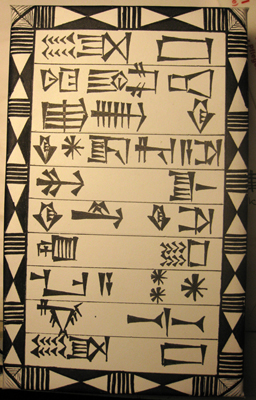 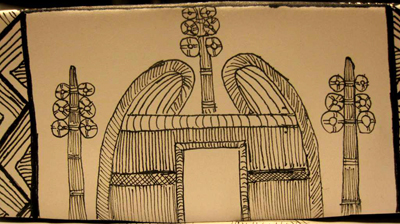 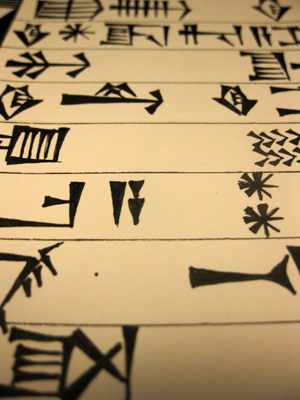 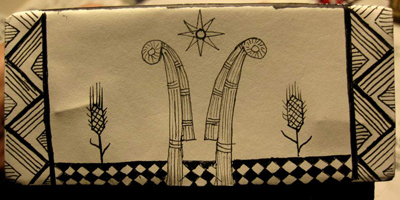 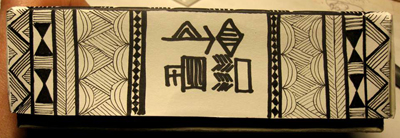 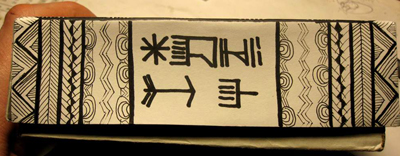 |
|
svladu
dubsartur (junior scribe)

Posts: 13 
|
Post by svladu on Jan 12, 2016 12:07:35 GMT -5
Sheshki, I have seen your work and the work of the other people. My approach is this: I learn three new signs every day. Each day I practice the all the signs i know already from the section i am currently at. When i finish a section I practice ALL the signs i have learned for about a week or two and I too, write whole pages with the signs until I am sure I properly know them. That is why I said I work slowly through the workbook. I also want to practice with clay discs that on one side have the sign and on the other have the name/value and use them like flashcards. I only have one such a disc I made as a test, but I will present them here when I have some. PS. I also found the sequence of the signs like a poem  |
|
|
|
Post by sheshki on Jan 12, 2016 19:22:42 GMT -5
Have you tried to write on plasticine instead of clay? Works great for practicing and is easy to re-use.
|
|
nemequm
dubsartur (junior scribe)

Posts: 12
|
Post by nemequm on Jan 13, 2016 17:06:08 GMT -5
(This thread is actually the thing which got me here so I think it really is time to post here!) Flash cards are like the best thing ever. (For many other things also) I guess I wouldn't have learnt any Babylonian signs without an Anki deck (flashcards on computer) a former student and our teacher had made. For Sumerian we didn't have such thing so I didn't learn so many signs there... Unfortunately for you (and fortunately for me) the deck is in Finnish, so I guess it would be a bit annoying to share for non-Finnish speakers. I did real flash cards for Sumerian (not on clay but on Fimo mass), but I became lazy and didn't use them... my suggestion for writing material is Fimo or similar bake-in-oven-to-make-it-hard -mass. Then you can both use the same stuff again and again, and if you managed to do something worth keeping you can bake it. And yes, I have also written cuneiform to cookies, chocolate, clay, sand and so on  Writing is in a way even more cooler than reading (Especially because my skills are not enough for reading anything very interesting...). But it wasn't me who used a piece of firewood to write cuneiform to muddy ground ("I didn't have anything else to demonstrate"), it was my classmate... One of my cuneiform related dreams is to bake my own clay tablets with (camp)fire - I don't know so much about how they did it 4000 years ago, but something similar to that anyway. Luckily we have a summer tradition relevant to that here in Finland - we tend to burn bonfires on Midsummer so I'd have a good excuse to have a big campfire for a long time  And not only "I", but I'd have a friend with me to try that, so we're looking forward to the summer now. |
|
|
|
Post by sheshki on Jan 15, 2016 14:42:23 GMT -5
|
|
|
|
Post by us4-he2-gal2 on Jan 23, 2016 10:13:19 GMT -5
Shulgi - nice art work  Looks like reedhut with ringposts, maybe from Uruk period cylinder seal? In any case the cuneiform etc. look correct. |
|
nemequm
dubsartur (junior scribe)

Posts: 12
|
Post by nemequm on Apr 6, 2016 16:33:16 GMT -5
I wonder if anyone happens to have pictures of people (youself, perhaps  ) actually writing cuneiform to clay/clay-like materials? This thread is full of awesome pictures (and I don't have just now time to read all the messages, sorry..!) - but I'd be interested in a photo of actual writing process. I need that kind of a photo for an advertisement of a (noncommercial) project, and I don't have any good photos myself. Please send me a message if you think you might have a suitable photo & it would be okay to use it. I can of course then give more details where it would go  |
|
|
|
Post by sheshki on Apr 22, 2016 18:19:55 GMT -5
I played around a bit with my camera and my bike lamp. Was out tonight to take a picture of Nannar, but he was hidden behind clouds.  |
|
nemequm
dubsartur (junior scribe)

Posts: 12
|
Post by nemequm on Apr 23, 2016 14:51:56 GMT -5
Finally I managed to post something here \o/ I don't have any proper camera right now, so sorry about blurry pictures. I went to Aboa Vetus, the museum of Middle Ages Turku (old capital of Finland). There was some wax tables and I guess they were for children to practise writing Middle Ages Style, but my first though when seeing a stylus there was that I have to try cuneiform. Result: the stylus used for wax tables was far too thick & not sharp, it really didn't work out. Also I didn't have any notes with me there so I really didn't remember most of the signs correctly : D (tried to write Lu Shulmum as always)  And here is one older one, my second try of writing cuneiform to gingerbread dough. (First was a year ago & the signs completely disappeared in the oven) Still not very good, but at least something almost readable. I'm not sure of one of the writings here, I guess it's a (Finnish) name of somebody, I don't remember/can't read anymore. Inspiration for this time was of course this.I guess the reason for my failure at the first time was not to write deep enough (how that's supposed to say, don't know, but I guess you understand). And that blog also said that they waited for hours before baking, I was too impatient for that but I waited for 30 minutes or something while baking other gingerbread.  I have also other this kind of small projects, but I don't have pictures of them or the pictures are on my old computer or something like that... |
|
nemequm
dubsartur (junior scribe)

Posts: 12
|
Post by nemequm on Jul 6, 2016 17:12:33 GMT -5
Sheshki asked pictures about our project of baking clay tablets with campfire, so here you have them finally. This is the first picture, there are like 10 more  Most of the tablets broke into pieces like I had feared. I guess the mesopotamians were better at baking than us! We had some tips from our friends who have done this kind of stuff before, and still. We've actually been lazy to try to clean up those tablets after baking, and I'm not sure how I should be able to tell if they like like 'become baked' (I guess there's a word for that in English but I have no idea what it would be). So I don't know if it was worth trying or not  We actually have posted quite many other things which could be also here in Twitter... I try to find some time to make a topic advertising our twitter & asking other people twitter tips, but now I'll just leave it here. |
|
|
|
Post by us4-he2-gal2 on Jul 12, 2016 22:26:29 GMT -5
Hello nemequm - I assume based on your introduction post that this "us" , the people making cuneifrom tablets and baking them, is a group of students from Helsinki perhaps? In any case, looka likw fun and some pretty good results! Is this just for fun or recommended practice by some Helsinki professors? In any case , thanks for sharing with us and adding to the cuneiform diary threaD  |
|